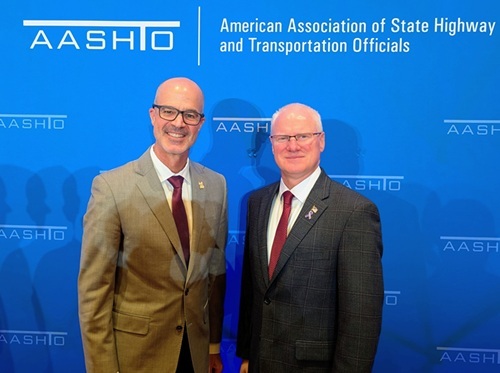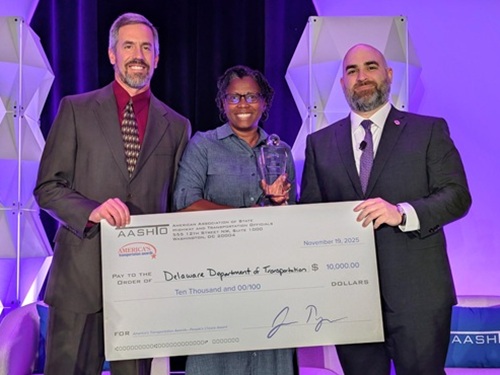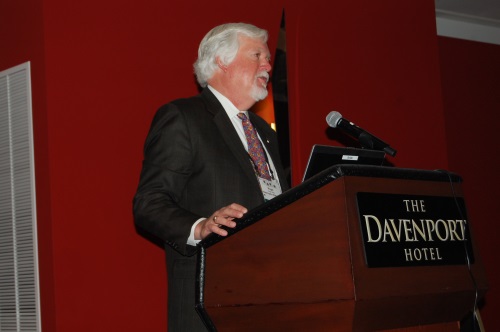Roger Millar, secretary of the Washington Department of Transportation, sees many challenges ahead for state DOTs – especially as pressure on existing capacity keeps rising while the funding required to keep the state’s transportation network ship-shape continues to shrink.
“We like to talk about traffic congestion as an issue, but it is actually a symptom of a larger problem – and the problem is we don’t provide affordable housing and transportation solutions,” he explained during the keynote speech at the American Association of State Highway and Transportation Officials 2018 Joint Policy Committee meeting in Spokane, Washington, on July 18.
“We have a rich list of transportation options for the rich that can afford to live in our cities – the rest are forced to drive. And they drive vehicles that often can’t make the trip” because of the condition they are in, Millar (seen below) said.
 “Washington state family after Washington family keeps finding out that the only house they can afford is miles away from where they work,” he pointed out. “And we have 50 incidents a day on Interstate 5 where cars and trucks are breaking down; vehicles that should not be on road but are. Executive housing and Walmart jobs is not a housing solution – that only puts more people on road.”
“Washington state family after Washington family keeps finding out that the only house they can afford is miles away from where they work,” he pointed out. “And we have 50 incidents a day on Interstate 5 where cars and trucks are breaking down; vehicles that should not be on road but are. Executive housing and Walmart jobs is not a housing solution – that only puts more people on road.”
Millar’s comments came as the lead-in to a panel discussion among state DOT CEOs (seen below) that included: Scott Bennett, director of the Arkansas DOT and chair of AASHTO’s committee on planning; Matt Garrett, director of the Oregon DOT and chair of the committee on environment and sustainability; Pete Rahn, secretary of the Maryland DOT and chair of the funding and finance committee; Leslie Richards, secretary of the Pennsylvania DOT and chair of the active transportation committee; and Greg Slater, administrator of the Maryland State Highway Administration and chair of the data management and analytics committee
 Millar – who serves as the chair of AASHTO’s special committee on freight – noted that building more highway capacity to solve congestion issues “isn’t the answer” for his state largely due to the expense and the fact that Washington’s gas tax revenues are in the main going to pay for bonds that funded previous infrastructure projects.
Millar – who serves as the chair of AASHTO’s special committee on freight – noted that building more highway capacity to solve congestion issues “isn’t the answer” for his state largely due to the expense and the fact that Washington’s gas tax revenues are in the main going to pay for bonds that funded previous infrastructure projects.
“We have the second highest gas tax in the country” with the state’s levy at 49.4 cents per gallon, Millar noted. “We have better than doubled the gas tax since 2000. But what concerns me with all that money is that it pays off bonds. By 2027, about 71 percent of the gas tax will be going to pay off bonds – so we’ll be sending the bulk of the gas tax to the bank.”
And building more capacity is fiscally out of the question anyway, he added.
“We asked ourselves, what would it cost to solve traffic congestion? To be able to drive 60 mph on the interstate whenever we wanted to? We found out it would cost $115 billion, or a $2.20 to $2.50 per gallon increase in the gas tax,” Millar said.
“So what we are talking about when try to solve congestion is something financially impossible to do,” he pointed out. “Congestion is not a failure on the state DOT’s part – it is a problem we simply cannot solve. And this does not address growth in the economy or capacity on other routes, for what happens at the end of ramp to a local road when you double or triple size of freeway?”
As a result, Millar said WSDOT is “looking for a path forward in congested world” to find ways to “advance next generation transportation investments so we are stewards of system and not just the builder of projects.”
He said one technology, like express toll lanes, is helping WSDOT “better manage our concrete; we can move 30 percent more people via the same pavement with express toll lanes. So we must consider that before expanding the highway.”
Millar pointed out that managing demand on the system is the key. “Our biggest source of capacity in the system is reducing demand; getting more people to telework, travel at off-peak hours, and by making off-system travel improvements such as adding bike lanes changes demand on system,” he explained. “That way we add capacity but only where it makes sense.”
Another issue is improving transportation system safety, especially when it comes to roadway fatalities. “We accept death on the highway as a cost of business – that is appalling,” Millar noted. “Look at the cost of that. Congestion costs us $2 billion to $ 5 billion, but [roadway] fatalities and accidents have over $8 billion in impact. So safety is a bigger cost issue for us yet is the smallest of our programs.”
In the end, he said “being willing and able to take some risks” will be critical for state DOTs to tackle future challenges.
“I’ve been in this business for 40 years and we need to acknowledge when something is not working and thus be willing to try something different,” Millar added. “Simply put, we cannot build our way out of congestion. Together I think we can fix these problems. Together with the state DOT community we can fix the transportation problems facing our country.”
 Top Stories
Top Stories
New AASHTO Leadership Elected at 2025 Annual Meeting
November 21, 2025 Top Stories
Top Stories

